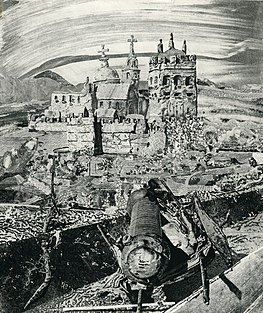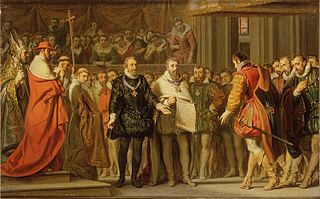 W
WThe French Wars of Religion were a prolonged period of war and popular unrest between Catholics and Huguenots in the Kingdom of France between 1562 and 1598. It is estimated that three million people perished in this period from violence, famine, or disease in what is considered the second deadliest religious war in European history.
 W
WThe Second Italian War (1499–1504), sometimes known as Louis XII's Italian War or the War over Naples, was the second of the Italian Wars; it was fought primarily by Louis XII of France and Ferdinand II of Aragon, with the participation of several Italian powers. In the aftermath of the First Italian War, Louis was determined to press his claim on the thrones of Milan and Naples. And in 1499, Louis XII invaded Lombardy and seized Milan, to which he had a claim in right of his paternal grandmother Valentina Visconti, Duchess of Orléans.
 W
WThe Italian War of 1521–1526, sometimes known as the Four Years' War, was a part of the Italian Wars. The war pitted Francis I of France and the Republic of Venice against the Holy Roman Emperor Charles V, Henry VIII of England, and the Papal States. The conflict arose from animosity over the election of Charles as Emperor in 1519–20 and from Pope Leo X's need to ally with Charles against Martin Luther.
 W
WThe Italian war of 1536–1538 was a conflict between King Francis I of France and Charles V, Holy Roman Emperor and King of Spain. The objective was to achieve control over territories in Northern Italy, in particular the Duchy of Milan. The war saw French troops invading Northern Italy, and Spanish troops invading France. The Truce of Nice, signed on June 18, 1538, ended hostilities, leaving Turin in French hands but affecting no significant change in the map of Italy. Overall, Spain increased its control over Italy, signifying the end of Italian independence. The war strengthened animosity between the Spanish and French, and reinforced ties between France and the Ottoman Empire which had sided with Francis I against Charles V.
 W
WThe Italian War of 1542–1546 was a conflict late in the Italian Wars, pitting Francis I of France and Suleiman I of the Ottoman Empire against the Holy Roman Emperor Charles V and Henry VIII of England. The course of the war saw extensive fighting in Italy, France, and the Low Countries, as well as attempted invasions of Spain and England. The conflict was inconclusive and ruinously expensive for the major participants.
 W
WThe Italian War of 1551–1559, sometimes known as the Habsburg–Valois War and the Last Italian War, began when Henry II of France declared war against Holy Roman Emperor Charles V with the intent of recapturing Italy and ensuring French, rather than Habsburg, domination of European affairs. Historians have emphasized the importance of gunpowder technology, new styles of fortification to resist cannon fire, and the increased professionalization of the soldiers.
 W
WThe Italian Wars, often referred to as the Great Wars of Italy and sometimes as the Habsburg–Valois Wars, were a long series of wars fought between 1494 and 1559 in Italy during the Renaissance. The Italian peninsula, economically advanced but politically divided among several states, became the main battleground for European supremacy. The conflicts involved the major powers of Italy and Europe, in a series of events that followed the end of the 40-year long Peace of Lodi agreed in 1454 with the formation of the Italic League.
 W
WThe War of the League of Cambrai, sometimes known as the War of the Holy League and several other names, was a major conflict in the Italian Wars of 1494–1559. The main participants of the war, fought from 1508 to 1516, were France, the Papal States, and the Republic of Venice, joined at various times by nearly every significant power in Western Europe, including Spain, the Holy Roman Empire, England, the Duchy of Milan, the Republic of Florence, the Duchy of Ferrara, and Swiss mercenaries.
 W
WThe siege of Paris took place in 1590 during the French Wars of Religion when the French Royal Army under Henry of Navarre, and supported by the Huguenots, failed to capture the city of Paris from the Catholic League. Paris was finally relieved from the siege by an international Catholic and Spanish army under the command of Alexander Farnese, Duke of Parma.
 W
WThe Peace of Vervins or Treaty of Vervins was signed between the representatives of Henry IV of France and Philip II of Spain under the auspices of the papal legates of Clement VIII, on 2 May 1598 at the small town of Vervins in Picardy, northern France, close to the territory of the Habsburg Netherlands.
 W
WThe Treaty of Troyes of 1564 was an agreement between the rivaling Kingdoms of England and France after the ejection of English forces from France in 1563 which recognized French ownership of Calais in return of France's payment to England 120,000 crowns.